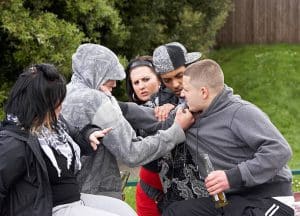Introduction

Perspectives of Youth in Gangs
Youth in gangs and How they effect National Economy. It goes without saying that gangs are an issue in many American neighborhoods. Less well recognized, though, is how young people involved in gangs impact the US economy. The short- and long-term detrimental effects of gang activity on the economy will be discussed in this article.
The American History of Youth Gang Membership
The United States youth in gangs has a long history of youth gang membership dating back to the early 1800s. New York City was the birthplace of gangs, and they swiftly extended to other significant American cities.
Originally, young people organized gangs to defend themselves against crime and violence. But over time, gangs have started engaging in a variety of criminal enterprises, including prostitution, drug sales, and robberies.
The economy is negatively impacted by the existence of gangs. Violence, theft, and property damage are frequently the results of gang activities. This can make it difficult for locals to feel comfortable in their own communities and discourage businesses from setting up shop in gang-ridden regions.
Furthermore, the illicit actions of gangs may cause local and state governments to lose out on tax money. Lastly, the costs of looking into and prosecuting offenses involving gangs are borne by the criminal justice system.
Gangs’ Effect on the Economy
Gangs have a devastating and far-reaching economic impact. Gangs are a drain on community resources, divert funds from respectable companies, and lower property values. Furthermore, gangs frequently commit crimes that cost the tax payers millions of dollars annually in court fees and law enforcement expenses.
There are also other detrimental effects of gang involvement on the community’s economy. For instance, companies could be hesitant to open in places where gang activity is prevalent. This may result in fewer jobs being available as well as a reduction in the tax base overall. Furthermore, gang involvement frequently results in higher insurance costs for the entire neighborhood.
The human cost of gangs is among their most detrimental consequences on the economy. Gang members are more prone to commit violent crimes, which have the potential to cause fatalities or major injuries. In addition to gang members themselves, friends and family suffer from the psychological and financial effects of gang membership.
Young people in gangs
The characteristics of gang members
Since gangs are present in every community in the nation, there is no universal description of a gang member. However, gang members frequently possess the following traits:
-Being poor -Member of a minority -Male -Being in the 12- to 24-year-old age range
Numerous gang members may fall into more than one of these categories, and these demographics are not exclusive of one another. For instance, gang membership is disproportionately represented by minorities and the impoverished.
The bulk of gang members are men, and their ages range from 12 to 24 on average. The sense of community and belonging that gangs provide to these young people frequently draws them in. They can also be trying to find a way to make money or protection from other gangs.
An area’s economy and level of crime and violence can both be significantly impacted by the presence of gangs. Gangs frequently commit crimes including drug sales, theft, and violence, which can raise the overall crime rate in a neighborhood. This might hinder the growth of businesses and discourage families from relocating to places that they consider to be dangerous.
Causes of Youth Gang Membership
Teenagers join gangs for a variety of reasons. Among the most typical causes are:
Seeking acceptance and a sense of belonging.
Sensing insecurity and the need for safety.
Desiring to have a sense of authority and control.
Being driven by a desire for material goods and money.
Taking inspiration from friends, relatives, or other community members who are gang members.
Programs for Prevention and Intervention
Numerous preventative and intervention programs are available to aid youth who are already involved in gangs as well as to keep them from entering.
Drug abuse resistance education programs, such as D.A.R.E., aim to teach youth the skills necessary to withstand peer pressure while also educating them on the risks associated with drug use and gang membership. Additionally, after-school activities can give children a positive and safe place to hang out after school, away from the influence of gangs.
Gang Alternatives Inc. and other intervention organizations assist gang members who wish to give up their gang lifestyle. These initiatives give gang members the tools and assistance they need to transform their life for the better.
Early intervention is essential to preventing youth membership in gangs. Working with children from a young age will enable us to provide them with the skills necessary to avoid gangs and have successful, productive lives.
American Gangs
In the United States, there are thought to be about 30,000 gangs. These gangs engage in a variety of illegal activities, such as extortion, violence, and drug trafficking. Each year, this action costs the US economy billions of dollars.
The social fabric of communities is significantly impacted by the existence of gangs. Because gang members are more prone to commit crimes and act violently, the local population may become more distrustful and fearful of them. Families may find it challenging to feel comfortable in their own homes and for companies to operate.
There are indirect expenses related to gang activities in addition to the direct expenditures. Children of gang members, for instance, are more likely to experience academic difficulties and quit out. This may result in a vicious cycle of poverty and criminality that is hard to escape.
It’s critical to handle the gang issue if we hope to strengthen the country’s economy. This entails trying to stop young people from ever entering gangs in the first place and supporting those who wish to break free from gang life.
The impact of gangs on the country’s economy
An estimate of the annual cost of gangs to the US economy is $33 billion, according to a recent analysis. This amount covers costs for law enforcement, healthcare, and lost production.
The study also discovered that violent crime in the US is disproportionately committed by gangs. Indeed, an estimated 40% of violent crimes in the country are committed by gang members.
The effects of gangs on the US economy are extensive and profound. The annual cost of healthcare related to gang violence is estimated to be $11 billion. This covers both upfront expenses like hospital stays and ongoing expenses like mental health care.
The expense to taxpayers of law enforcement’s efforts to suppress gang activity is likewise substantial. An estimated $1.6 billion of federal funds are spent annually on law enforcement efforts related to gangs. An additional $5.5 billion is added to this amount by state and local governments.
Gangs have substantial financial costs, but they also have a large human cost. Every year, gang violence causes thousands of injuries and fatalities. Gang involvement can also result in lower productivity and higher rates of absence from work or school. The fact is that gangs are very detrimental.
The various kinds of gangs
There are numerous varieties of gangs, and each has its own distinct set of rituals, practices, and ideologies. All gangs, though, have one thing in common: they all want to use unlawful means to get money. This can involve robberies, drug sales, human trafficking, and other illegal activities.
Given that gangs frequently commit acts of violence and property crimes, their existence can have a detrimental effect on the community. This may result in an increase in crime and violence, which would subsequently discourage investors and companies from setting up shop there. In the end, this can be detrimental to the country’s economy.
Young people in gangs
There are numerous explanations for why Youth in gangs join the gangs. Seeking a sense of community and belonging, some people become members of gangs. Some people join gangs in order to profit from illicit activities like prostitution or drug sales. Others join gangs to feel powerful and in control of their own life, or to defend themselves against other gangs.
For whatever cause, young people who join gangs frequently face detrimental effects that affect society at large in addition to the gang member themselves. Young people engaging in gang violence can cause property damage, casualties, and panic throughout communities. Gang members are more prone to commit crimes, which can hurt the economy by discouraging investment and travel as well as raising the price of security and law enforcement.
Why then do people still join young people in gangs? One explanation for this is the prevalence of gang culture among young people’s upbringing, which makes joining one seem like the right thing to do. People may think that there are more advantages to being in a gang than disadvantages, which is another explanation. However, it is undeniable that gangs have a detrimental effect on both society and the economy.
How to keep young people out of gangs
Many nations are becoming increasingly concerned about the increase in Youth in gangs. In addition to bringing crime and violence to our neighborhoods, gangs have a detrimental impact on the economy.
Although it’s a complicated problem, there are some things that may be done to help stop young people from joining gangs. Providing young people with alternatives to gang recruitment is one approach to stop them from becoming members. Young people can discover a feeling of purpose and belonging in programs such as sports teams, job training programs, and after-school activities that they might not find in gangs.
Supporting young individuals who run the danger of entering gangs is also crucial. Early intervention programs that provide guidance and assistance can significantly impact the life of a young individual. These initiatives can assist youth in defining their objectives and determining constructive means of achieving them.
Ultimately, it’s critical to deal with the underlying reasons of gang violence. Factors such as poverty, unemployment, and limited opportunities might contribute to an individual’s engagement in a gang. We can give all of our young people a better future by addressing these problems.

Final Thoughts on Youth in Gangs
The national economy is greatly impacted by Youth in gangs who are involved in gangs. They frequently engage in illegal activity that costs the government and corporations billions of dollars annually. Furthermore, they contribute to the socioeconomic issues plaguing our society, like housing insecurity, poverty, and low educational achievement. Although the precise financial cost of gang activity is impossible to calculate, it is certain that it has a negative impact on the economy of our country.


1 thought on “Youth In Gangs and How They Affect National Economy”